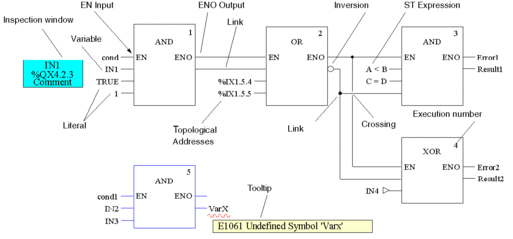Introduction
The FBD editor is used for graphical function block programming according to IEC 61131-3.
Representation
Representation of an FBD section:

Objects
The objects of the FBD (Function Block Diagram) programming language help to divide a section into a number of:
Elementary Functions (EFs),
Elementary Function Blocks (EFBs)
Derived Function Blocks (DFBs)
Procedures
Subroutine calls
Jumps
Links
Actual Parameters
Text objects to comment on the logic
Properties
FBD sections have a grid behind them. A grid unit consists of 10 coordinates. A grid unit is the smallest possible space between 2 objects in an FBD section.
The FBD programming language is not cell oriented but the objects are still aligned with the grid coordinates.
An FBD section can be configured in number of cells (horizontal grid coordinates and vertical grid coordinates).
The program can be entered using the mouse or the keyboard.
Input Aids
The FBD editor offers the following input aids:
Toolbars for quick and easy access to the desired objects
Syntax and semantics are checked as the program is being written.
Incorrect functions and function blocks are displayed in blue
Unknown words (e.g. undeclared variables) or unsuitable data types are marked with a red wavy line
Brief description of errors in the Quickinfo (Tooltip)
Information for variables and pins can be displayed in a Quickinfo (Tooltip)
type, name, address and comment of a variable/expression
type, name and comment of an FFB pin
Tabular display of FFBs
Actual parameters can be entered and displayed as symbols or topological addresses
Different zoom factors
Tracking of links
Optimization of link routes
Display of inspection windows


